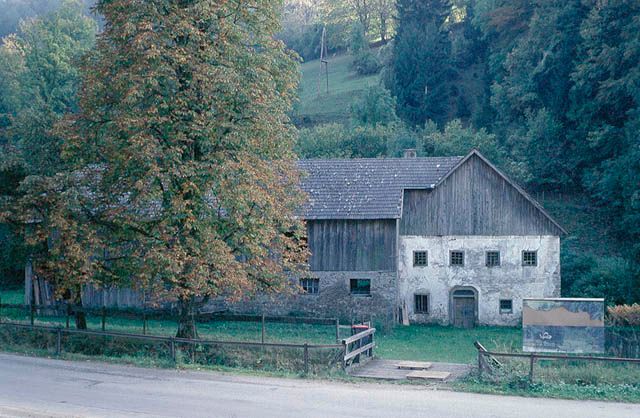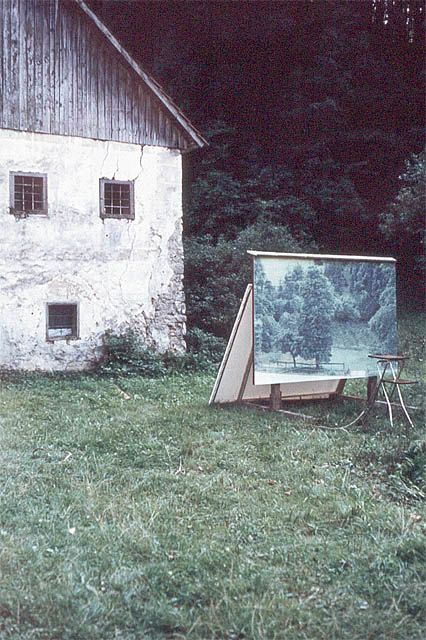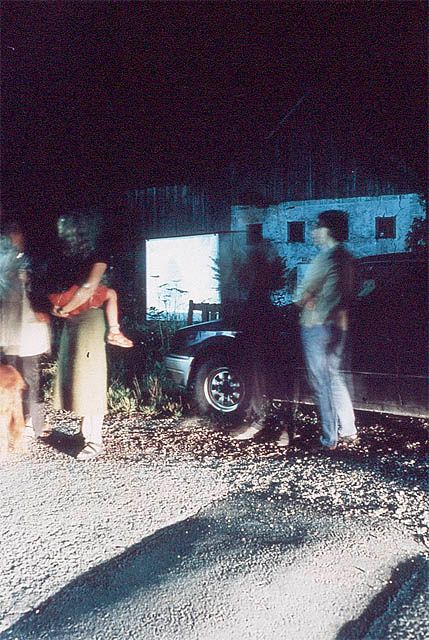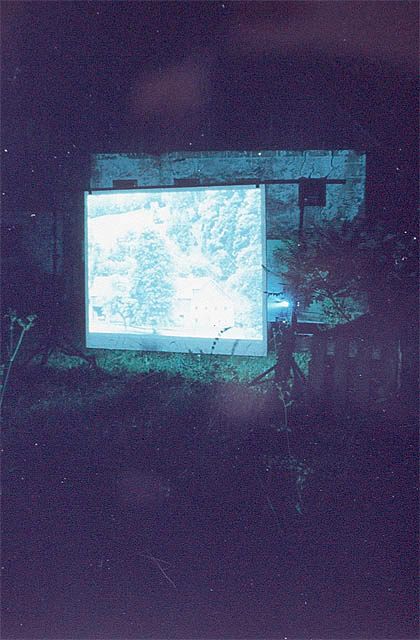Mixed Feelings
BackArtists
- With
Information
Reinsberg was chosen as the scene and production location fort he project 'Mixed Feelings', having previously been selected as the setting for 'Common Cause' in 1999. Five artists came to live in Reinsberg for an extended period of time to learn about the events, the history and the stories surrounding the village, and to familiarize themselves with people and institutions, with public life, social conflicts and strategies of self-portrayal for marketing purpose. The real effect of 'Mixed Feelings' was hidden between the lines. The preparations and development of the scenario were initiated by Karl Prüller, car mechanic and untiring promoter of cultural activities in the village, who incidentally was responsible for the castle ruin experiment with all ist performances as well as for promoting organic gastronomy in the village. 'Mixed Feelings' clearly reflected the kind of intense and discursive operation mentioned above. The project of 2001 proved a continuous tightrope walk in as much as artists had to be found who were keen enough to do on-site piece-work and became engaged in internal as well as external discussions. They then had to be encouraged to go into what seemed at first sight a village very much closed in itself, to carry out research there, to speek approaches and prepare possible stagings. Local residents were at the same time reserved and open, they showed interest, wanted to participate in discussions yet were quick to cover up situations and would alternately open and close doors. As both the preliminary research and the actual project were carried out in a true-to-life situation and some of the artists showed a keen interest in dealing with concrete village history/stories, it was possible to find a real and tangible basis for discussion and critique which is quite rare in the arts world otherwise. At Reinsberg, however, it was not possible to remove oneself from the core issue or to make critique part of a closed art system. The fabric of stories/history, of participiants and recipients was too closely knit for anyone to break away from. There was the case of Hofmühle (mill) where Ricarda Denzer and Barbara Kraus, in preparing ist history and the stories surrounding it, found themselves caught up in a discussion with one of the local families, the mayor and Mr.Prüller on how much biographical detail was to become part of the artistic work.
Conflicts were the inevitable consequence and the artists had to interrupt their work temporarily. Several talks were conducted and it soon became clear just how important individual biographies were for recognizing collective processes. Suddenly, looking at the dealing with an outsider’s life story was no longer considered an act of voyeurism but rather a way of coming to terms with common history outside any person’s private or family life. Many of the artists came from similar village or small-town backgrounds, a fact which opens up additional perspectives fort he whole scenario. The boundaries between people’s own history, their stories and memories, and those of the village had become blurred. The title is descriptive of the structure, the procedure and the actual course of the project. It refers to the "mixed feelings" people have when "strangers" enter their village. There are the "mixed feelings" of being at home, in a place of intimacy and familiarity, while at the same time being on the outside, being looked at suspiciously, having no access to communities, etc. And then there are the "mixed feelings" of being looked at as an artist, a young person showing interest, but also as an intruder, a stranger, someone from Vienna (the city!), or even a left-wing activist. The former supermarket Gruber, located next to the church in the village center, was adapted as the main communication hub. The Hofmühle, an old mill with a lot of history and many stories to tell, was chosen as a second focus fort he project.
Contributors
- Kuration
Contributions
Ricarda Denzer
"eigen" (peculiar)
The Hofmühle is a historical building dating back to the 16th century which has been left untouched in its original state. The artists, in investigating into its past, came across a number of stories about the previous occupants and their lives. Different accounts were given about some of the episodes concerning the miller and his daughter, depending on who was there to witness them or who related them. The house certainly gives rise to many speculations. Ricarda Denzer did a piece of work called "eigen" (peculiar) about one episode taken from the daughter's biography. "It was back in 1974. There was this story about a man. A letter arrived, not handwritten. Just individual letters cut out. It said: on such and such a day at such and such time the mill will blow up. The police came and father and daughter were evacuated. But nothing happened." A projection area was raised in front of the old mill to stage a video animation of an event announced 30 years earlier. This time, the mill duly blew up. Billboards similar to those near construction sites were then put up which showed the site the mill had stood/still stood on. All she heard from her father all life long was, "watch out, he doesn't want you he is only after the mill!"
Ricarda Denzer's second work is a 13 minute video which starts with view of the village and then slowly approaches the mill, focuses on it until it explodes and then comes to a stand-still with almost static pictures taken from the computer animation. Spectacular scenes of smoke and mist not unlike those created by phantasy computer games. Voices from the village talking about a woman who is different, has a different way of speaking, behaves differently, who doesn't want to or is unable to fit in - maybe she is sick - a woman marginalized and ultimately shut out. The voices are mixed with the voice of a commentator recounting brief episodes from fairy tales the woman had collected in an old textbook.
Hilde Fuchs
"Reflektorzone" (reflector zone)
Hilde Fuchs produced a series of installations called "Reflektorzone" (reflector zone) which consist primarily of marches and processions. The project refers to events in a village community which typically take place during church holidays, with special emphasis on processions and pageants. People in motion are set off against rigid structures and installations such as the holes dug along the sides of the road at regular intervals which are filled with birch branches during the Corpus Christi procession. They are used only once a year yet they are found throughout the village along the route the procession normally takes. In her installation, Hilde Fuchs used the holes to stand up raw birch loges the height of road pillars with red and white reflectors nailed to them. Photographs of various processions, both old and new, were placed on the cut surfaces of the poles. At the Kaufhaus Gruber a show of slides depicting historical and present day processions in the village was presented alongside a series of pictures taken recently of people's facial sections (the eyes of locals seen through the rear mirror of a car). The point was to compare the act of walking as a ritualised, collective movement to the act of driving as something individualised. The two opposites, i.e. the ritualised collective and the individual, the walking and the driving, were set off against each other throughout both installations. Additional focus is placed on what people perceive as they drive by or gaze on/in.
Oliver Hangl
"Reinswood"
Oliver Hangl drew on the unusually keen interest of the 900 soul community in cultural productions (of their own) to create his "Reinswood", which he developed in several parts. The success of productions like his is due in large measure to the multifunctional skills of some of the village's inhabitants (in their capacity as artists and organizers outside their jobs). Hangl simply decleared Reinsberg a "place of artists" for the duration of the exhibition, turning it into a stage for collective and individual performances. In a first step, he has the letters "REINSBERG", 5m high and 30m long, mounted on the castle hill Hollywood style. He then goes on to stage a kind of casting in the church square. People from the village arriving in their Sunday suits are made up and styled to pose for a shooting. How does a village prepare for public appearance? With flower orgies organised by the society for the improvement of local amenities, folklore competitions, women's caps knitted in gold, suits, make-up, posing on their tractors, posing with their cows? What media are used to transmit such a performance? (gold caps on the Internet?) Oliver Hangl operates at the crossroads of theatre, film and visual arts. He creates his performances with the help of actors and musicians, and tries to link elements of film and theatre - focussing on visual details and switching between space and time to create the kind of immediacy of expressive gesture which is unrepeatable. He stages artistc glimpses of scenes which the audience is invited to enrich with the clichés and fictions of their own identity. The construction and perception of these images are examined by means of the various media - film, video, music, entertaining multimedia live acts, selected according to the situation or context described.
Barbara Kraus
"Schneckenfalle" (snail trap)
"Schneckenfalle" (snail trap), a performance by Barbara Kraus, also had its origins in the stories around the old mill. However, the discussions about the mill eventually led the artist to change her mind about a woman she was originally going to create with the material she had come across. For her performance she came up with a hybrid between snail and human being, a metaphor for the ambivalence of desire. "The desire for circumstances that are dry, ordered, clearly defined and comrehensible, in contrast to the appeal and fascination of damo, slimy-slippery, dark holes." (Barbara Kraus) The figure thus created was seen in the streets of Vienna days before its appearance, it came to Reinsberg before the opening, attended the Reinsberg nights, a village festival which took place at the same time, and then as night fell, appeared before the audience, having previously been announced on TV. Shrieking sharply it pushed its way to the speaker's desk, its gestures full of sexual connotations. Surrounded by luscious lettuce plants it began to preach about the "church's fear of women", using a language reminiscent of antiquated threatening speeches. In the second part of the performance, the snail withdrew into a house made of leaves, slipped out of its previous role to read out texts and protocols about the treatment of women during the inquisition and the persecution of witches. All this was performed in the village square in front of the church which was part of the reason for the heated discussions and strong reactions among the local population both during and after the event. It was no longer the project, the works, the nature or content of the performance they were concerned about, but the daring costume, the sexual connotations of the gestures and the obvious attacks on the church.
Rita Vitorelli
"die Burg, die Kirche, das Gasthaus und ..." (the castle, the church, the village inn and ...)
"die Burg, die Kirche, das Gasthaus und ..." (the castle, the church, the village inn and ...) was produced by Rita Vitorelli specially for the village of Reinsberg. The first impression she had of Reinsberg was that of a village without billboards. She then went on to find out more about a handicraft typical for this alpine area, the painting of qwooden shooting marks. What advertising and painted marks have in common is their idealisation of reality. Creating the illusion of a better world and questioning the one we have are also elements inherent in the act of painting. Rita Vitorelli's painted plates depict the "Sights" of the village - the castle ruin, the church and the village inn. Her exasperation with presenting something purely for the purpose of tourist maraketing is expressed in her paintings. Some of them are completed, others are only sketched out, done carelessly or left deliberately unfinished. The pictures miss their porpose, they disillusion. Procedural representation is a quality of painting which Rita Vitorelle refers to more and more in the course of her work. "Mixed Feelings" provides both the formal basis and the content matter she draws on. The location she chose for her plates in a meadow at the entrance to zhe village is suggestive of a number of things: is this new development territory, are these new buildings sites which at a second glance turn out to be well-known chlichés? Is this a new advertising strategy being tried out, that of presenting "the sight" of a village before the actual village?




